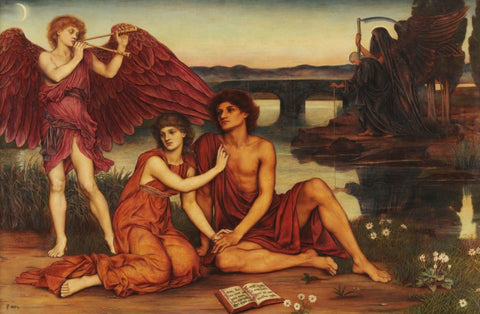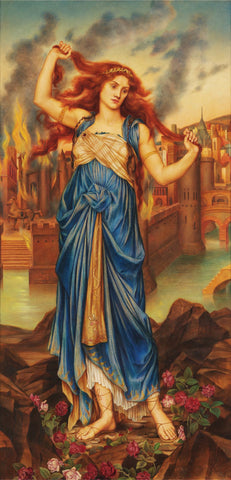Evelyn De Morgan (1855 – 1919) emerged as a painter who transcended the societal norms of her era. Born into privilege, she challenged the status quo, using her richly colored canvases to advocate for feminism, spirituality, and pacifism—a message still resonant today.
Brief Biography of Evelyn De Morgan
- 1855: Born in London to upper-class parents Percival Pickering Q.C. and Anna Maria Spencer Stanhope.
- Early years: Received an exceptional education in languages, mathematics, and classics; began writing poetry and exploring artistic expression.
- 1870s: Began formal art education with private drawing lessons and study trips to France and Italy.
- 1870s-1880s: Overcame family opposition to pursue a career in art; gained support from her father for further art education.
- Late 1870s: Attended the Slade School of Fine Art, where she excelled and won scholarships for her talent.
- 1883: Met William De Morgan, a ceramicist, whom she later married; continued her successful art career alongside her husband.
- 1889: Publicly supported women's suffrage by signing the Declaration in Favour of Women’s Suffrage.
- 1919: Passed away, leaving behind a legacy of groundbreaking art and advocacy for social causes.

The Cadence of Autumn
Evelyn De Morgan's Early Years and Education
Born in 1855 in London to upper-class parents, Percival Pickering Q.C. and Anna Maria Spencer Stanhope, Evelyn's upbringing was steeped in privilege. Despite societal expectations, she received an education typically reserved for boys, delving into languages, sciences, and the arts.

Love’s Passing (1883), oil on canvas, by Evelyn De Morgan
Artistic Ambitions and Opposition of Evelyn De Morgan
Despite her family's reservations, Evelyn pursued her passion for art, supported by her father's encouragement. She faced opposition from her mother, who preferred a more conventional path for her daughter. Nevertheless, Evelyn persisted, honing her skills and expressing her beliefs through her art.

Evelyn De Morgan
Pioneering Themes in Evelyn De Morgan's Art
Evelyn's paintings became a platform for social commentary, advocating for causes such as women's suffrage and pacifism. Her works often featured allegorical symbolism drawn from mythology, challenging societal norms and highlighting the plight of marginalized groups.


Helen of Troy, Evelyn De Morgan - Bookmark
Mastery of Technique and Style
Evelyn's dedication to her craft was evident in her meticulous attention to detail and her mastery of composition. Influenced by Italian Renaissance artists like Botticelli, her works exuded a luminous quality and a moral message that captivated viewers.

Cassandra, Evelyn De Morgan
Evelyn De Morgan's Legacy and Recognition
Despite facing obstacles and relative obscurity in her lifetime, Evelyn's legacy endures today. Her artworks, now curated by the De Morgan Foundation, continue to inspire and provoke thought, reminding us of the enduring power of art to challenge, uplift, and provoke change.
Through her unwavering determination and artistic brilliance, Evelyn De Morgan blazed a trail for future generations of artists, leaving behind a body of work that transcends time and speaks to the universal human experience.
 Flora (1894), oil on canvas, by Evelyn De Morgan
Flora (1894), oil on canvas, by Evelyn De Morgan

The Captives (c.1915), oil on canvas, by Evelyn De Morgan

The Dryad, Evelyn De Morgan

Lux in Tenebris, Evelyn De Morgan

S.O.S. Evelyn De Morgan
Passing of the Soul at Death (1917), oil on canvas, by Evelyn De Morgan 
Passing of the Soul at Death (1917), oil on canvas, by Evelyn De Morgan
